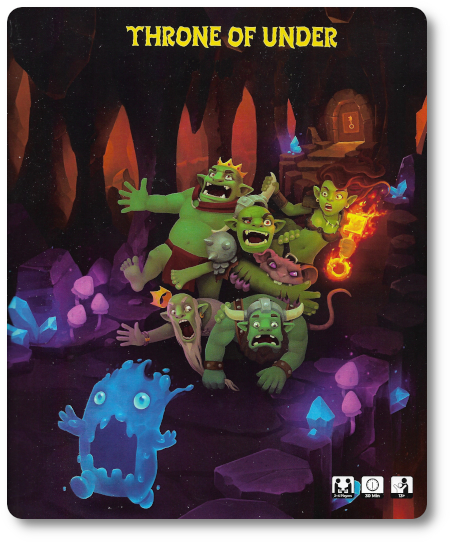 The Basics:
The Basics:
- For ages 10 and up (publisher suggests 13+)
- For 2 to 4 players
- Approximately 30 minutes to complete
Geek Skills:
- Counting & Math
- Logical & Critical Decision Making
- Reading
- Pattern/Color Matching
- Hand/Resource Management
Learning Curve:
- Child – Moderate
- Adult – Easy
Theme & Narrative:
- Race to the throne and power!
Endorsements
- Gamer Geek rejected!
- Parent Geek approved!
- Child Geek approved!
Overview
A general in the United States Army who commanded the Seventh United States Army in the Mediterranean theater of World War II, and the Third United States Army in France and Germany after the Allied invasion of Normandy in June 1944, George S. Patton, said: “Accept the challenges so that you can feel the exhilaration of victory.” In this game, players will take on the role of ambitious characters who compete in a race to a throne. If they get their first, they get to rule. However, only one butt can sit in that seat and the player’s opponents want that throne just as bad as they do. Get ready to race fast, battle hard, and try every trick in the book to trip up your opponents so you get to the throne first!
Throne of Under, designed by Seamus Cranley, Nastya Cranley and published by Incoming Studios, is comprised of one game board, four Characters (with stands), 16 Key tiles, one Boon card, one standard six-sided die, four Player Reference cards (referred to as “Cheatsheets”), 60 Adventure cards, 16 Occurance cards, and four Dragon cards. The cards come in standard size and “jumbo” size. The tiles and Characters are made of thick cardboard, as is the gameboard. Excellent quality throughout. The illustrations are also wonderful, full of color and detail.
Establishing the Underworld
To set up the game, complete the following steps. Note that your setup will be different per the number of players in the game, limiting the number of components used.
First, place the gameboard – which is the map of the location the players will be traversing – in the middle of the playing area and within easy reach of everyone who is playing. Next to the gameboard, take the Boon card and place it in its stand. Place the six-sided die next to the Boon card.
Second, have each player select a Character of their choice, affix a stand to it, and then place the Character to the “Start” position on the gameboard. Characters do not have any unique abilities or actions, making the selection process purely based on player preference.
Third, give to each player a set of four Key tiles (one purple, one green, one blue, and one red). Key tiles have two different sides. One side shows a key. The other shows an element. Have the players place their Key tiles so the element side is facing upward.
Fourth, take the Adventure cards, remove the noted number, and type per the number of players in the game (explained in the rule book). Any removed Adventure cards are placed in the game box. Shuffle the kept Adventure cards and deal six to each player. These cards are the player’s starting hand. They may look at their cards but should keep them hidden until revealed during gameplay. Place the remaining undealt Adventure cards face-down and to one side of the gameboard. This is the Adventure card draw deck for the duration of the game. Leave room next to it for a discard pile.
Fifth, shuffle the Occurance cards and place them face-down next to the Adventure card draw deck. This is the Occurance card draw deck for the duration of the game. Shuffle the Dragon cards, as well, placing them face-down next to the Occurance card draw deck. Dragons are the most powerful monster in the game, but they only come out if a specific Occurance card is drawn.
This completes the game setup. Determine who will be the first player and begin!
Race for Power
Throne of Under is played in rounds and turns with no set number of rounds per game. A player’s turn consists of four phases which are summarized here.
Phase One: Move
A player’s first action must always be moving towards the Throne Room on the gameboard (which is the objective). Note that players will not be able to enter the Throne Room until they possess all four Key tiles with the “key” side facing upward.
After that, a player may optionally use a “Portal” Action card to move their Character forward or backward, depending on their strategy and tactics. “Portal” Action cards allow the player to place their Character to the closest matching land element type shown on the card. And by “closest”, I mean the first occurrence of it from the player’s Character’s current position on the gameboard.
Two important points to make here. First, players may use “Portal” Action cards at any time during their turn, not just during this phase. Second, there is no limit to the number of “Portal” Action cards the player may use during their turn.
The map shows different lands and their associated element type, which is used both for the “Portal” Action card and battling monsters.
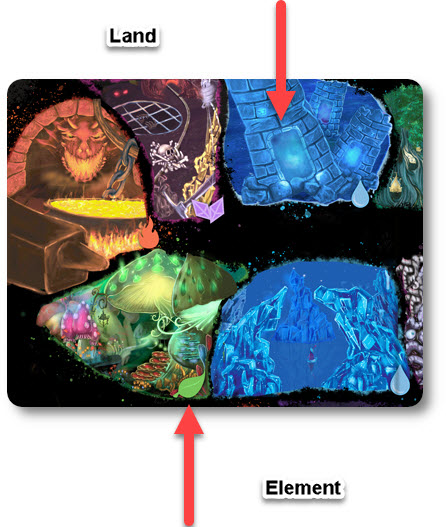
Phase Two: Dig
The player now draws an Action card and resolves it according to the type of card they selected.
“Trick”, “Portal”, “Hypnotize”, and “Power” Action cards are beneficial, but come at a cost. If the player wants to keep it, they add it to their hand but must end their turn skipping right to Phase Four. Or, the player may discard the Action card and draw another Action card. If the player discards a “Hypnotize” or “Portal” Occurance card, they must resolve it first, and then they can draw a new card.
“Trick” Action cards allow the player to tame a monster (referred to as “Faerumentals”) without being forced to move backward.
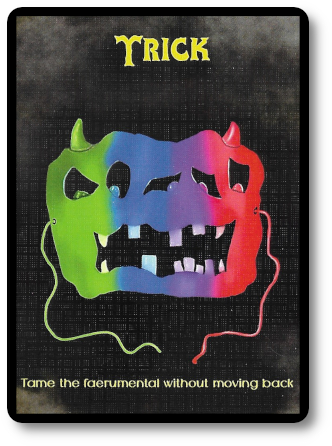
“Power” Action cards allow the player to defeat any monster during the current game round.
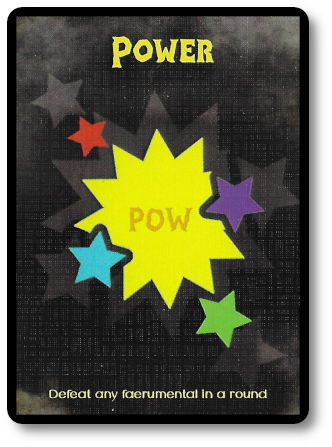
“Hypnotize” Action cards allow the player to steal a card at random from an opponent.

“Portal” Action cards allow the player to move back and forth on the game board, as described during phase one movement.
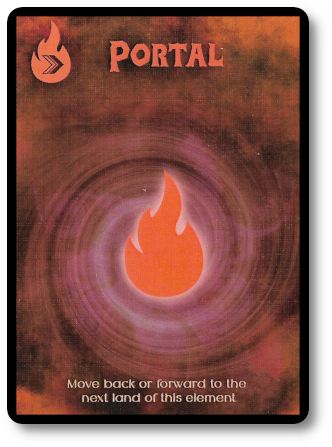
A player could also draw a monster. If they do, this ends the Dig phase and the player moves into their third phase.
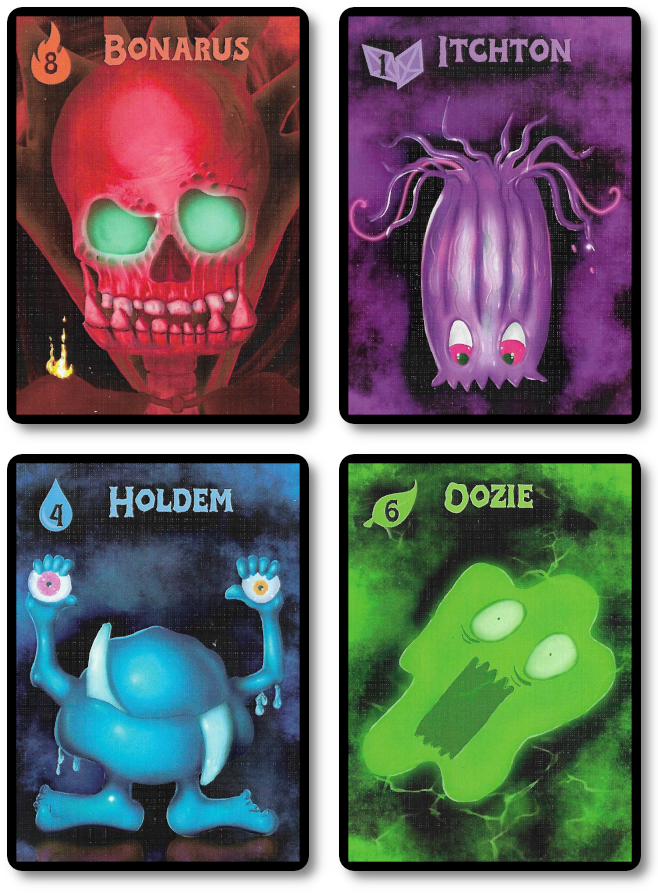
Phase Three: Battle
If the player drew a monster in the previous phase, they must now battle it. Place the drawn monster face-up in front of the player.
Battles consist of one or more rounds within the battle phase. The objective is to defeat the monster by using Action cards. Battles may be extended and made difficult by opponents who can play their cards against the player.
Defeating the Monster
To defeat the monster, the player can do any of the following:
- Play a monster card of the same element with a higher number.
- Play a monster card that matches the element of the current “land” space the player’s Character is currently occupying, but only if the drawn monster card is of a different land type.
- Play a “Power” card.
If the player can play a card as noted above, they have won the Battle. However, opponents can now add a new round of combat. In a two-player game, a player’s opponent may add as many rounds of combat as they like given their available cards. In a three and four-player game, each opponent can only add one round of additional combat each.
To add another round of combat, the opponent need only play a monster card from their hand of the same type already played during the battle, but the element can be different. The player must now defeat this monster using the same method as described above.
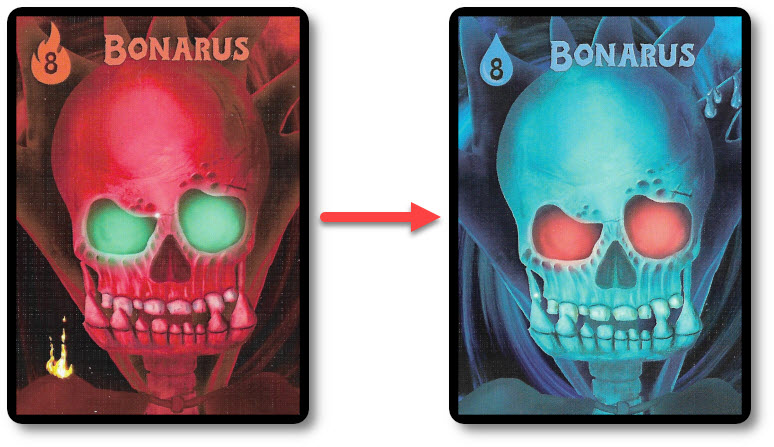
A player in battle may, if they like, play a “Portal” card at any time to teleport the battle to the noted nearest “land” space that matches the element displayed, backward or forwards from the player’s Character’s current position.
An opponent may elect to play a “Trick” card during the battle. If they do, they discard the “Trick” and take the player’s played monster card as their own, adding it to their hand. The player must now play a new monster card. And, of course, an opponent may play a “Portal” Occurance card, as well, but only if playing a two-player game.
If the player is able to defeat each of the monsters thrown at them, they are victorious! The player now turns over the Key tile that matches the element of the current “land”, showing its key side. The player also now draws the top-most Occurance card and resolves it. If the effect impacts all the players, resolve it in turn order sequence starting with the current player. The Occurrence card is then discarded.

If the player already has the key, they roll for a boon instead. This is done by rolling the die, matching the rolled result to the Boon card, and resolving it immediately.

Losing the Battle
Of course, it’s also possible that the player is unable to play a card during the battle. If this is the case, they have lost the battle but not the race! They take the monster into their hand and move their Character backward to the matching land of the monster they just collected. They may use this “tamed” monster later in the game, but the cost was to set them back a few spaces. Optionally, the player may play a “Trick” Action card and stay in the same land.
Regardless of the battle’s outcomes, all played cards are placed in the discard pile.
Phase Four: Refill
Starting with the current player and continuing in turn order sequence, each player refills their hand of cards to six. If the draw deck is depleted, shuffle the discarded cards and place it face-down to create the new card draw deck.
This ends the player’s turn. The next player in turn order sequence now takes their turn starting with phase one noted above.
The Final Battle and Victory
If the player has discovered all four keys, they may move into the “Throne Room”. They are now stuck in this room, along with any other players who have moved to this space.
The player immediately discards all “Portal”, “Power”, and “Trick” Action cards they have in their hand and draws a new card. If a “Portal”, “Power”, or “Trick” card is drawn, discard it and draw again. Keep drawing until a monster is revealed. The final battle now takes place!
If the player wins the battle, using the same battle rules as noted above, they can claim the throne and win the game!
If the player is unable to successfully complete the rounds of battle thrown at them, they take the undefeated monster into their hand, discarding all the cards used in the battle, and complete phase four as noted above. Keep the cards drawn at this time because they can be used against opponents on their turn. RETRIBUTION!!!!!
To learn more about Throne of Under, visit the game’s webpage.
Final Word
 The Child Geeks enjoyed the game for the most part. They found it frustrating when opponents play cards against them, but seemed to forget all about it once they were able to do the same to their peers in an act that can be described as “aggressive payback”. Of course, it didn’t take them long to realize that such a move was folly as it limited their own chances of winning battles in the future. After a few rounds, all the Child Geeks understood this and the card plays became less aggressive and more conservative. According to one Child Geek, “I like the game, love the artwork, and think it’s a little like Pokemon, but you don’t get to keep every monster you capture. I would play this again.” Another Child Geek said, “I was at first too fast to play attack cards and I didn’t do good in battle because I did that. This game taught me patience and to play my cards smart.” Or, put another way, it taught the Child Geeks the importance of hand management and thinking critically about when to play cards or hold them back. Regardless if that lesson was learned, all the Child Geeks agreed that Throne of Under was a big win.
The Child Geeks enjoyed the game for the most part. They found it frustrating when opponents play cards against them, but seemed to forget all about it once they were able to do the same to their peers in an act that can be described as “aggressive payback”. Of course, it didn’t take them long to realize that such a move was folly as it limited their own chances of winning battles in the future. After a few rounds, all the Child Geeks understood this and the card plays became less aggressive and more conservative. According to one Child Geek, “I like the game, love the artwork, and think it’s a little like Pokemon, but you don’t get to keep every monster you capture. I would play this again.” Another Child Geek said, “I was at first too fast to play attack cards and I didn’t do good in battle because I did that. This game taught me patience and to play my cards smart.” Or, put another way, it taught the Child Geeks the importance of hand management and thinking critically about when to play cards or hold them back. Regardless if that lesson was learned, all the Child Geeks agreed that Throne of Under was a big win.
 The Parent Geeks found Throne of Under to be simple, but pleasant. According to one Parent Geek, “The game is pretty straightforward and easy to pick up. I wouldn’t say it’s casual since you have to play pretty aggressively to win the game. Especially if you are playing with four players. The kids liked it and I liked playing it with the kids. That’s good enough for me.” Another Parent Geek said, “A racing game with cards to battle. I like the concept and it all worked pretty well. I didn’t get the cards I always wanted, but collecting new cards wasn’t much of a challenge. I did like how you have to win battles at certain locations to get keys, which made movement on the board tactical and strategic.” When at last a new ruler was declared, all the Parent Geeks agreed that the Throne of Under was worth their time.
The Parent Geeks found Throne of Under to be simple, but pleasant. According to one Parent Geek, “The game is pretty straightforward and easy to pick up. I wouldn’t say it’s casual since you have to play pretty aggressively to win the game. Especially if you are playing with four players. The kids liked it and I liked playing it with the kids. That’s good enough for me.” Another Parent Geek said, “A racing game with cards to battle. I like the concept and it all worked pretty well. I didn’t get the cards I always wanted, but collecting new cards wasn’t much of a challenge. I did like how you have to win battles at certain locations to get keys, which made movement on the board tactical and strategic.” When at last a new ruler was declared, all the Parent Geeks agreed that the Throne of Under was worth their time.
 The Gamer Geeks appreciated the artwork and the gameplay but all agreed that the game was too simple for their tastes. According to one Gamer Geek, “The game is well designed and thought out, but just not a game that appealed to me. I wanted a game with deeper thought and gameplay. The game didn’t deliver that.” Another Gamer Geek said, “Good enough for the family and for the kids to be sure, but for gaming elitists, it falls short. The random card draws to help you win battles felt a bit desperate at times and I am not a fan that a player can get a key by simply rolling for it. Overall, I think the game is great for casual players but should be left on the shelf for people who want a deeper game.” When the last card was played and the game put back on the shelf, all the Gamer Geeks agreed it was there it should stay.
The Gamer Geeks appreciated the artwork and the gameplay but all agreed that the game was too simple for their tastes. According to one Gamer Geek, “The game is well designed and thought out, but just not a game that appealed to me. I wanted a game with deeper thought and gameplay. The game didn’t deliver that.” Another Gamer Geek said, “Good enough for the family and for the kids to be sure, but for gaming elitists, it falls short. The random card draws to help you win battles felt a bit desperate at times and I am not a fan that a player can get a key by simply rolling for it. Overall, I think the game is great for casual players but should be left on the shelf for people who want a deeper game.” When the last card was played and the game put back on the shelf, all the Gamer Geeks agreed it was there it should stay.
 Throne of Under was a lot of fun to play with the family, especially if they are casual players. The game asks everyone to be aggressive, but not in a way that I found to be over the top or absurdly disruptive to the gameplay. A player can – and most likely will – be bombarded with extra monsters during the game, but we found this to only be the case when they had collected all the keys and going for the throne or were about to their fourth and final key. The ability to thwart your opponent’s progress is nice, but this type of game mechanic always comes with the risk of disruption. Which it did, but not to a point where it ever got out of hand.
Throne of Under was a lot of fun to play with the family, especially if they are casual players. The game asks everyone to be aggressive, but not in a way that I found to be over the top or absurdly disruptive to the gameplay. A player can – and most likely will – be bombarded with extra monsters during the game, but we found this to only be the case when they had collected all the keys and going for the throne or were about to their fourth and final key. The ability to thwart your opponent’s progress is nice, but this type of game mechanic always comes with the risk of disruption. Which it did, but not to a point where it ever got out of hand.
I liked the need to jump around the game board. This served as a way for players to leverage what they had in their card hand to their advantage. This light tactical addition to the gameplay made it much more interesting to navigate around the gameboard, forcing the players – and myself – to consider my “position” before I considered my “options”. A neat approach that kept me smiling.
Overall, I enjoyed the game a good deal. Casual and quick, with plenty of surprises and random outcomes that players can navigate through. I never once felt stuck or lacking things to think about. The end result was a game that I enjoyed from start to finish. Give it a try and see if the race to the throne was worth racing to put on your table.
This game was given to Father Geek as a review copy. Father Geek was not paid, bribed, wined, dined, or threatened in vain hopes of influencing this review. Such is the statuesque and legendary integrity of Father Geek.



